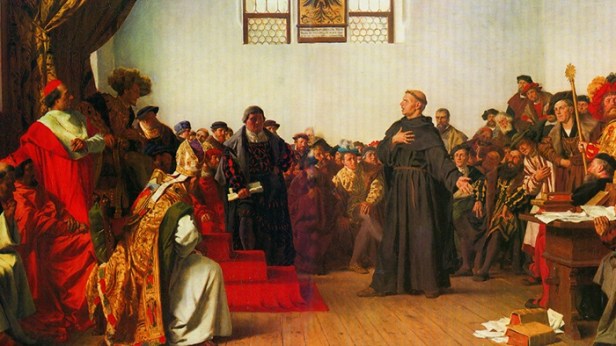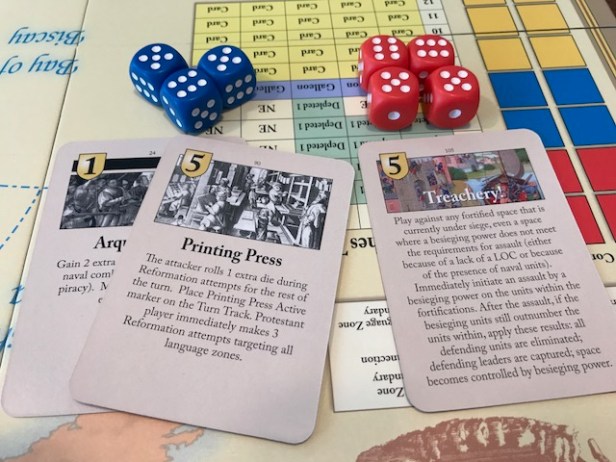
In Action Point 1, we talked about the Diplomacy Deck and the 2-player variant as well as the first round of any game of Here I Stand and the playing of the mandatory event card Luther’s 95 Theses. In this Action Point, we will also take a look at a special phase that only happens during Turn 1, the Diet of Worms!
The fourth phase of Turn 1 is always the Diet of Worms. This is the historical reference to the famous picture above, where in 1521, Luther was paraded in front of the newly appointed Holy Roman Emperor Charles V who reviewed Luther’s controversial teachings before the German legislature in the city of Worms. Diet is a reference to a formal meeting, not a weight-loss plan. Here the Protestant player is going up against the Papacy player to see whose way of thinking is correct. This battle represents a debate of theological ideas and concepts and can be used as a means to convert more spaces to Protestant religious influence in Germany or to save recently converted spaces back to Catholic religious control.
The procedure for this phase is pretty simple and involves each player choosing a card that represents their level of commitment as determined by the number of CP or Command Points (the numeric value printed in the yellow shield in the upper left corner of the card) of the chosen card. The Papal player is allowed to play 2 cards as the second card represents the opposition of the Hapsburg empire to the change. These 2 cards are simply added together to determine the number of dice he gets to roll. The cards are then revealed and the CP number determines the base number of dice that the players will roll. This base is modified for the Protestant player by adding 4 to the CP number. The dice for each side are then rolled and hits are scored on each roll of a 5 or 6. The number of hits is then compared and the winner is chosen who will then get to flip a number of spaces equal to the difference in hits. A Protestant victory means that Luther was eloquent in his arguments and moved many powerful leaders to his side, which leaders then assisted in carrying his message back to their people who then accept the message of Luther’s Reformation and leave the Catholic faith. A victory for the Papacy means that Luther was unconvincing and that the counterarguments of the Catholic clergy convinced many to turn away from Luther.
In our play of the game, as you can see in the picture below, I was able to play a 5 CP card (Treachery!) and added 4 to that value as the Protestant player to roll a total of 9 dice. I ended up rolling only 4 hits. The Papal player controlled by Alexander played a 5 CP card (Printing Press) and a 1 CP card (Arquebusiers) and was able to roll 6 dice scoring 3 hits. The Protestant player’s 4 hits minus the Papal player’s hits of 3 equaled 1 and I was able to choose one space to change from Catholic religious influence to Protestant. The limiting factor is that this space had to be located in the German language zone and be adjacent to a Protestant religious influence space just as it would be with any typical Reformation attempt. I chose Erfurt which would be a difficult space to turn through the normal process.

This concludes our look at the Turn 1 only phase Diet of Worms. I really love the attempt by the designer Ed Beach of Here I Stand to create these interesting mechanics to represent the historical events in the game play. I am sure that it was not easy and in essence, he had to design two separate games within the same game, including the religious struggle between the Papacy and the Protestants and then the more traditional battle for land control between everyone else in Central Europe. It makes for a very rich and enjoyable experience that teaches me something about history and I am grateful for that. Nice work Ed!
In our next Action Point, we will take a look at three specific available Religious Actions, including Biblical Translations, Publishing of Treatises and Calling Theological Debates. This is about to get very interesting as someone can potentially be burned at the stake or disgraced.
-Grant

We love the prospect of burning someone at the stake. Whenever a debate is called we always say the Pope is in the mood for BBQ!
Strangely enough, we’ve never had a BBQ. We’ve had several Catholic debaters disgraced though.
LikeLike